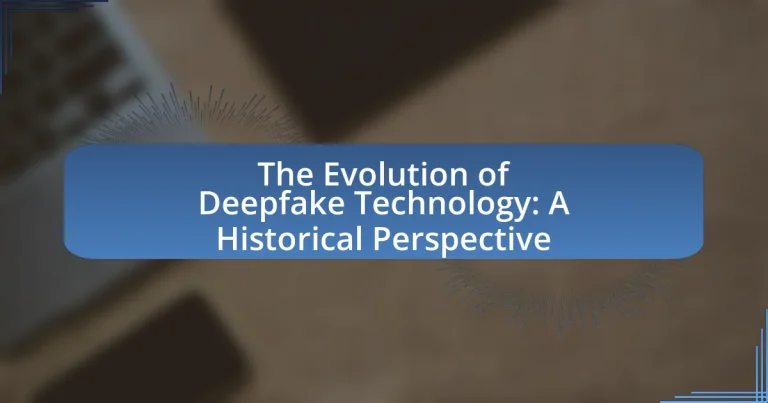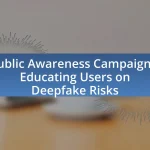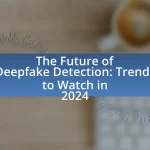Deepfake technology, a sophisticated form of artificial intelligence, enables the creation of highly realistic fake videos and audio by manipulating existing media through deep learning algorithms, particularly generative adversarial networks (GANs). The term “deepfake” emerged in 2017, highlighting both its creative potential in entertainment and its risks related to misinformation and privacy violations. This article explores the historical milestones in the evolution of deepfake technology, the underlying technologies that facilitate its creation, its applications across various sectors, and the ethical and legal debates it has sparked. Additionally, it addresses the implications of deepfakes on media trust, societal norms, and the future trends that may shape its development and regulation.
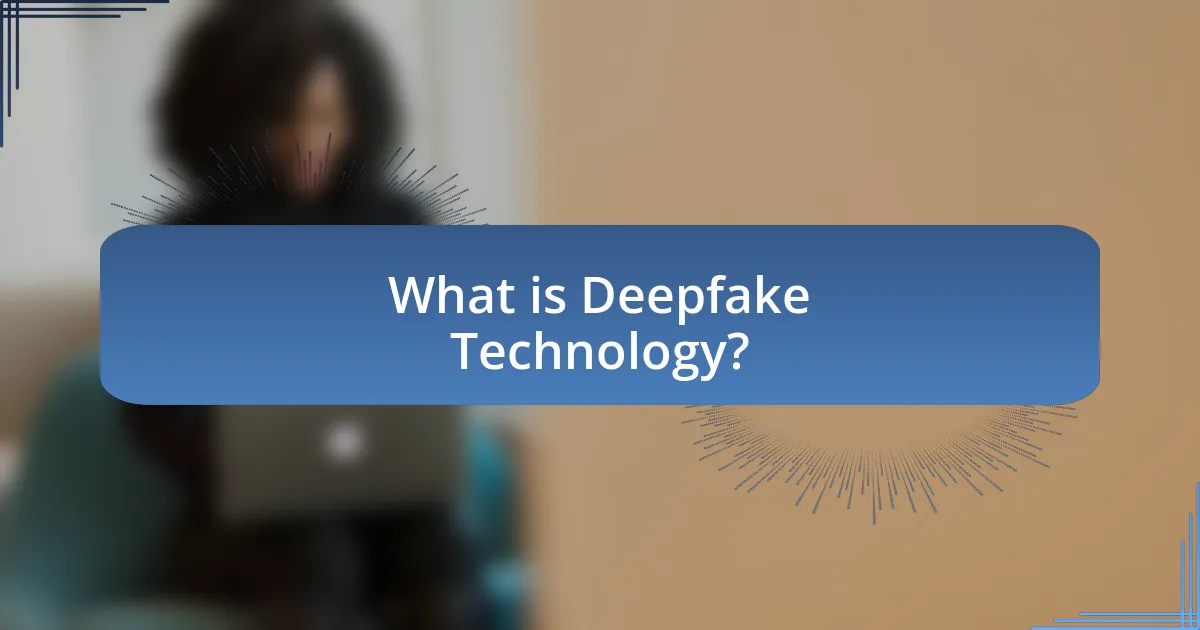
What is Deepfake Technology?
Deepfake technology is a form of artificial intelligence that creates realistic-looking fake videos or audio recordings by manipulating existing media. This technology utilizes deep learning algorithms, particularly generative adversarial networks (GANs), to analyze and replicate the facial expressions, voice, and mannerisms of individuals, resulting in highly convincing imitations. The accuracy of deepfake technology has been demonstrated in various applications, including entertainment and misinformation, highlighting its potential for both creative and malicious uses.
How did the term “deepfake” originate?
The term “deepfake” originated from a combination of “deep learning” and “fake.” It was first popularized in December 2017 when a Reddit user known as “deepfakes” began sharing manipulated videos that used artificial intelligence to swap faces in adult content. This user utilized deep learning techniques, specifically generative adversarial networks (GANs), to create realistic-looking fake videos, which led to widespread discussions about the implications of such technology. The emergence of the term coincided with growing concerns over the ethical and societal impacts of synthetic media.
What technologies underpin deepfake creation?
Deepfake creation is primarily underpinned by artificial intelligence technologies, particularly deep learning algorithms. These algorithms, such as Generative Adversarial Networks (GANs), enable the synthesis of realistic images and videos by training on large datasets of existing media. GANs consist of two neural networks, a generator and a discriminator, that work in opposition to improve the quality of the generated content. Additionally, techniques like autoencoders and facial recognition software contribute to the manipulation and replacement of faces in videos, enhancing the realism of the deepfakes. The effectiveness of these technologies is evidenced by their ability to produce highly convincing results, as demonstrated in various studies and applications within the field.
How do deepfakes differ from traditional forms of media manipulation?
Deepfakes differ from traditional forms of media manipulation primarily in their use of advanced artificial intelligence techniques, specifically deep learning algorithms, to create hyper-realistic alterations of video and audio content. Traditional media manipulation often involves simpler techniques such as cropping, splicing, or using filters, which can be more easily detected and typically result in less convincing alterations. In contrast, deepfakes leverage neural networks to analyze and replicate facial expressions, voice patterns, and movements, making it significantly harder for viewers to discern the authenticity of the content. This technological advancement has raised concerns about misinformation and trust in media, as evidenced by studies showing that deepfake videos can mislead audiences more effectively than traditional manipulated media.
What are the primary applications of deepfake technology?
The primary applications of deepfake technology include entertainment, education, and security. In entertainment, deepfakes are used to create realistic visual effects in films and video games, enhancing storytelling by allowing for the seamless integration of digital characters or altering actors’ appearances. In education, deepfake technology can be utilized for creating engaging learning materials, such as realistic simulations for training purposes. In the security domain, deepfakes pose challenges, as they can be employed in misinformation campaigns or identity theft, necessitating the development of detection tools to combat these threats.
In what ways is deepfake technology used in entertainment?
Deepfake technology is used in entertainment primarily for creating realistic visual effects, enhancing storytelling, and enabling digital resurrection of actors. This technology allows filmmakers to generate lifelike representations of characters, which can be used to create scenes that would be difficult or impossible to film traditionally. For instance, in movies like “Rogue One: A Star Wars Story,” deepfake techniques were employed to recreate the likeness of the late actor Peter Cushing, allowing him to appear in a new role. Additionally, deepfake technology is utilized in music videos and advertisements to superimpose faces or alter performances, providing a fresh and engaging viewer experience. The accuracy of deepfake technology has been validated by its increasing adoption in high-profile projects, demonstrating its potential to revolutionize visual media.
How is deepfake technology impacting social media and communication?
Deepfake technology is significantly impacting social media and communication by enabling the creation of hyper-realistic manipulated videos and audio that can mislead viewers. This technology allows users to produce content that can distort reality, leading to misinformation and the potential for reputational harm. For instance, a study by the University of California, Berkeley, found that deepfake videos can be indistinguishable from real footage, raising concerns about their use in spreading false narratives. Furthermore, social media platforms are grappling with the challenge of detecting and mitigating the spread of deepfakes, as evidenced by Facebook’s initiative to combat misinformation through partnerships with fact-checking organizations.
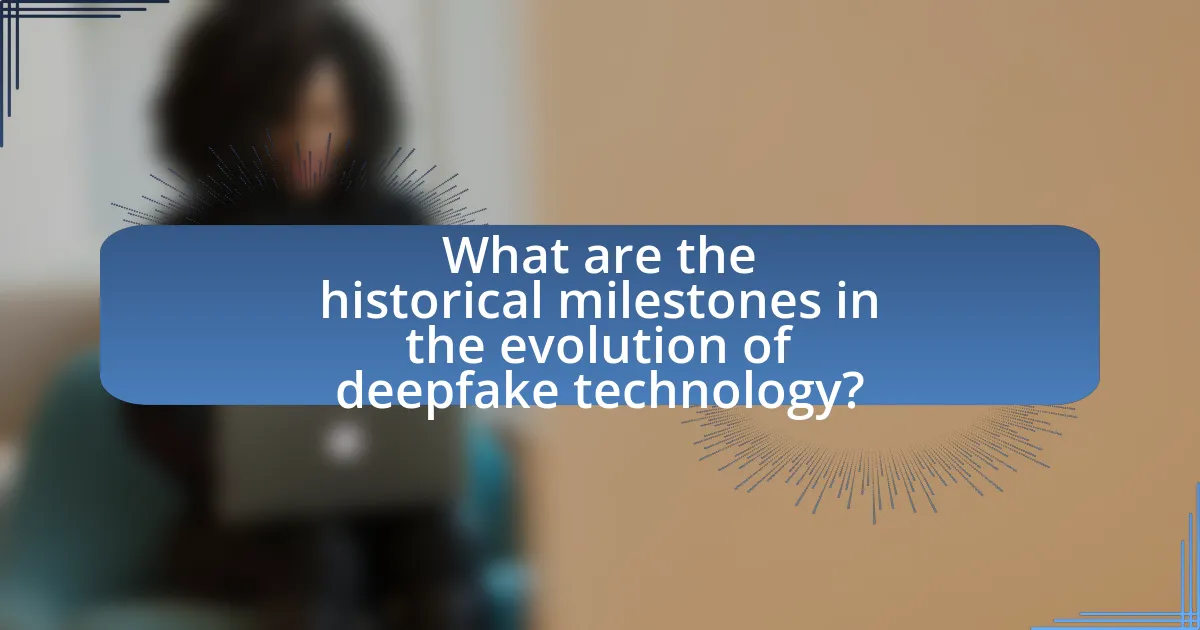
What are the historical milestones in the evolution of deepfake technology?
The historical milestones in the evolution of deepfake technology include the development of the first generative adversarial networks (GANs) in 2014, which laid the groundwork for creating realistic synthetic media. In 2017, the term “deepfake” emerged when a Reddit user began using GANs to swap faces in videos, showcasing the potential for manipulation. The release of the open-source software FakeApp in 2017 further democratized access to deepfake creation, allowing more users to generate altered videos. In 2018, researchers at the University of California, Berkeley, published a paper demonstrating the ability to create high-quality deepfake videos, highlighting advancements in the technology. By 2019, deepfake detection tools began to emerge in response to growing concerns about misinformation, marking a significant shift towards addressing the ethical implications of the technology. These milestones illustrate the rapid development and increasing accessibility of deepfake technology, alongside the rising awareness of its potential risks.
What significant developments led to the creation of deepfakes?
The creation of deepfakes was significantly influenced by advancements in artificial intelligence, particularly in generative adversarial networks (GANs). GANs, introduced by Ian Goodfellow and his colleagues in 2014, enable the generation of realistic images and videos by training two neural networks against each other. This technology laid the groundwork for deepfake applications, allowing for the manipulation of visual content with unprecedented realism. Additionally, the proliferation of high-quality datasets and improvements in machine learning algorithms have further enhanced the capabilities of deepfake technology, making it more accessible and effective for users.
How did advancements in artificial intelligence contribute to deepfake technology?
Advancements in artificial intelligence significantly enhanced deepfake technology by improving the algorithms used for generating realistic synthetic media. Specifically, the development of Generative Adversarial Networks (GANs) in 2014 allowed for the creation of highly convincing fake images and videos by pitting two neural networks against each other, which refined the output quality. Research by Ian Goodfellow and his team demonstrated that GANs could learn to produce images that closely mimic real ones, thus laying the groundwork for deepfake applications. Furthermore, improvements in machine learning techniques, such as transfer learning and facial recognition, have enabled more accurate and efficient manipulation of video content, making deepfakes increasingly accessible and sophisticated.
What role did early video manipulation techniques play in the evolution of deepfakes?
Early video manipulation techniques laid the foundational framework for the development of deepfakes by demonstrating the potential for altering visual content convincingly. Techniques such as morphing and face swapping, which emerged in the late 20th century, showcased how digital tools could manipulate images and videos to create realistic alterations. For instance, the 1995 film “Forrest Gump” utilized digital compositing to insert Tom Hanks into historical footage, illustrating the early integration of video manipulation in storytelling. These advancements in video editing paved the way for machine learning algorithms, particularly Generative Adversarial Networks (GANs), which are central to deepfake technology today. The evolution from basic manipulation to sophisticated deepfake creation reflects the progression of computational power and algorithmic innovation, highlighting the significant role early techniques played in shaping the capabilities of modern deepfake applications.
What key events have shaped public perception of deepfake technology?
Key events that have shaped public perception of deepfake technology include the release of the “DeepNude” app in 2019, which generated significant backlash for its potential misuse in creating non-consensual explicit images. This event highlighted ethical concerns and led to widespread media coverage, influencing public awareness and fear regarding deepfakes. Additionally, the viral deepfake video of former President Barack Obama, created by BuzzFeed in 2018, demonstrated the technology’s capabilities and risks, prompting discussions about misinformation and trust in media. The emergence of deepfake detection tools, such as those developed by Facebook and Microsoft, further reflects the growing recognition of the technology’s implications, as these initiatives aim to combat the potential for deception and manipulation in digital content.
How did the 2017 deepfake scandal influence media and technology discussions?
The 2017 deepfake scandal significantly influenced media and technology discussions by highlighting the potential for misuse of artificial intelligence in creating realistic but fabricated content. This incident prompted widespread concern among media professionals, policymakers, and technology experts regarding the implications of deepfake technology for misinformation, privacy, and security. As a result, discussions intensified around the need for regulatory frameworks and ethical guidelines to address the challenges posed by deepfakes, leading to initiatives aimed at developing detection tools and promoting media literacy. The scandal underscored the urgency for collaborative efforts between technology companies and regulatory bodies to mitigate the risks associated with deepfake technology, as evidenced by subsequent research and policy proposals aimed at combating digital deception.
What legal and ethical debates have emerged from the rise of deepfakes?
The rise of deepfakes has sparked significant legal and ethical debates primarily surrounding issues of consent, misinformation, and potential harm. Legal discussions focus on the lack of existing laws specifically addressing the creation and distribution of deepfakes, leading to challenges in prosecuting malicious uses, such as defamation or identity theft. Ethical concerns center on the implications of deepfakes for privacy rights and the potential for deepfakes to mislead the public, particularly in political contexts, as evidenced by instances where manipulated videos have influenced public opinion and electoral outcomes. These debates highlight the urgent need for regulatory frameworks that can effectively address the unique challenges posed by deepfake technology.
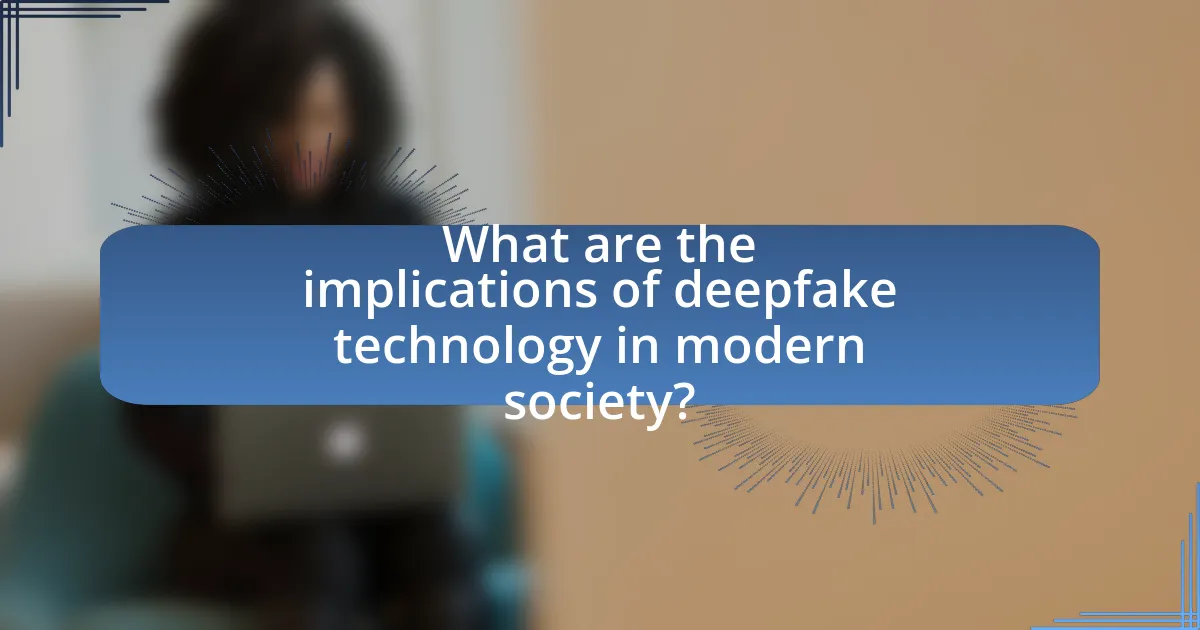
What are the implications of deepfake technology in modern society?
Deepfake technology has significant implications in modern society, primarily affecting misinformation, privacy, and security. The ability to create hyper-realistic fake videos can lead to the spread of false information, as seen in political contexts where manipulated videos can mislead voters or damage reputations. For instance, a study by the Stanford Internet Observatory found that deepfakes were used in disinformation campaigns during elections, highlighting their potential to disrupt democratic processes. Additionally, deepfakes pose privacy risks, as individuals can be depicted in compromising situations without their consent, leading to reputational harm and emotional distress. Furthermore, the technology raises security concerns, particularly in the realm of identity theft and fraud, where deepfakes can be used to impersonate individuals for malicious purposes. These implications underscore the need for regulatory frameworks and technological solutions to mitigate the risks associated with deepfake technology.
How does deepfake technology challenge the concept of truth in media?
Deepfake technology challenges the concept of truth in media by enabling the creation of hyper-realistic but fabricated audio and visual content that can mislead audiences. This manipulation of media blurs the line between reality and fiction, making it increasingly difficult for viewers to discern authentic information from deceptive representations. For instance, a study by the University of California, Berkeley, found that deepfakes can significantly influence public perception, as individuals often struggle to identify altered content, leading to misinformation and erosion of trust in media sources.
What are the potential risks associated with deepfake technology?
The potential risks associated with deepfake technology include misinformation, identity theft, and erosion of trust in media. Misinformation can lead to the spread of false narratives, as deepfakes can convincingly depict individuals saying or doing things they never did, which has been evidenced in political contexts where fabricated videos influenced public opinion. Identity theft occurs when individuals’ likenesses are manipulated without consent, potentially damaging reputations and privacy. Furthermore, the erosion of trust in media is significant; as deepfakes become more prevalent, audiences may struggle to discern real from fake content, undermining the credibility of legitimate news sources.
How can deepfake technology be used for positive social impact?
Deepfake technology can be used for positive social impact by enhancing educational experiences through realistic simulations and interactive learning environments. For instance, educators can create lifelike avatars of historical figures to engage students in immersive history lessons, making learning more relatable and impactful. Research from Stanford University highlights that such immersive experiences can improve retention rates by up to 30%. Additionally, deepfake technology can aid in mental health therapy by allowing patients to interact with virtual representations of therapists, providing a safe space for communication and expression. This application has been shown to reduce anxiety levels in patients, as reported in a study published in the Journal of Medical Internet Research.
What measures can be taken to mitigate the risks of deepfake technology?
To mitigate the risks of deepfake technology, implementing robust detection tools is essential. These tools utilize machine learning algorithms to identify manipulated media by analyzing inconsistencies in video and audio data. For instance, research from the University of California, Berkeley, demonstrates that deepfake detection systems can achieve over 90% accuracy in identifying altered videos. Additionally, promoting digital literacy among the public can help individuals recognize and critically assess the authenticity of media content. Furthermore, establishing legal frameworks that penalize malicious use of deepfakes can deter potential offenders, as seen in various jurisdictions that have enacted laws targeting deepfake-related crimes.
What tools and techniques exist for detecting deepfakes?
Tools and techniques for detecting deepfakes include machine learning algorithms, digital forensics, and blockchain technology. Machine learning algorithms, such as convolutional neural networks (CNNs), analyze video and audio inconsistencies, identifying artifacts that indicate manipulation. Digital forensics tools, like Deepware Scanner and Sensity AI, utilize advanced detection methods to assess the authenticity of media. Blockchain technology can provide a secure method for verifying the provenance of digital content, ensuring its integrity. Research has shown that these methods can achieve high accuracy rates in distinguishing real from fake media, with some algorithms reporting over 90% effectiveness in controlled environments.
How can individuals and organizations protect themselves from deepfake misuse?
Individuals and organizations can protect themselves from deepfake misuse by implementing advanced detection technologies and promoting digital literacy. Advanced detection technologies, such as machine learning algorithms specifically designed to identify inconsistencies in video and audio content, have been developed to combat deepfakes effectively. For instance, a study by the University of California, Berkeley, demonstrated that AI-based detection systems can achieve over 90% accuracy in identifying manipulated media. Additionally, promoting digital literacy among employees and the public can help individuals recognize potential deepfake content, reducing the likelihood of falling victim to misinformation. Training programs that educate users on the characteristics of deepfakes and the importance of verifying sources can significantly enhance awareness and resilience against such threats.
What are the future trends in deepfake technology?
Future trends in deepfake technology include advancements in detection methods, increased accessibility for creators, and the potential for ethical regulations. As deepfake technology evolves, researchers are developing sophisticated algorithms to identify manipulated content, which is crucial for combating misinformation. Additionally, tools for creating deepfakes are becoming more user-friendly, allowing a broader range of individuals to produce high-quality content. This democratization raises concerns about misuse, prompting discussions around ethical guidelines and regulations to govern the technology’s application. The combination of these trends indicates a dual focus on innovation and responsibility in the deepfake landscape.
How might advancements in AI further evolve deepfake capabilities?
Advancements in AI are likely to enhance deepfake capabilities by improving the realism and efficiency of synthetic media generation. Techniques such as generative adversarial networks (GANs) are becoming more sophisticated, allowing for higher resolution and more convincing alterations in video and audio. For instance, recent developments in AI have led to models that can generate deepfakes in real-time, significantly reducing the time and computational resources required for production. Additionally, the integration of machine learning algorithms that can better understand and replicate human emotions and expressions will further blur the line between reality and artificiality. This evolution is evidenced by the increasing use of deepfake technology in entertainment and marketing, where companies leverage these advancements to create engaging content that resonates with audiences.
What ethical considerations will shape the future development of deepfake technology?
The ethical considerations that will shape the future development of deepfake technology include privacy rights, consent, misinformation, and potential harm. Privacy rights are crucial as individuals may not want their likenesses used without permission, leading to legal implications. Consent is essential, as using someone’s image or voice without their agreement raises ethical concerns. Misinformation is a significant issue, as deepfakes can be used to create false narratives, impacting public opinion and trust in media. Potential harm involves the risk of defamation or emotional distress caused by malicious deepfake content. These considerations are increasingly recognized in discussions among policymakers and technologists, emphasizing the need for regulations and ethical guidelines to govern the use of deepfake technology.
